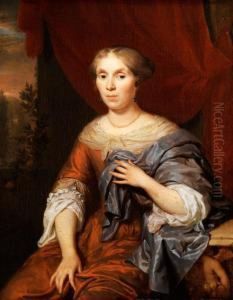Jan Verkolye Paintings
Jan Verkolye, sometimes spelled Jan Verkolje or Johannes Verkolje, was a notable Dutch painter, engraver, and draughtsman of the Dutch Golden Age, born in 1650 in Amsterdam. His multifaceted artistic career spanned various genres, including portraits, genre scenes, and historical subjects, reflecting the eclectic tastes and interests of the period. Verkolye's work is distinguished by its elegance, meticulous attention to detail, and the subtle interplay of light and shadow, characteristics that have drawn comparisons to the works of his contemporaries and predecessors in the Dutch Golden Age of painting.
Verkolye began his artistic training under the guidance of Jan Andrea Lievensz, a lesser-known artist who nonetheless provided a solid foundation in the arts. However, it was Verkolye's own natural talent and his ability to assimilate various influences that propelled his career forward. He became particularly adept at capturing the textures of fabrics and the translucency of materials, a skill that made his portraits highly sought after. His genre scenes, often depicting everyday life with an idealized veneer, were imbued with a sense of intimacy and warmth that resonated with patrons and art lovers alike.
Throughout his career, Verkolye was not just a painter but also a skilled engraver and draughtsman, demonstrating versatility across different mediums. His engravings, characterized by fine detail and delicate lines, contributed to the dissemination of his and his contemporaries' styles beyond the borders of the Dutch Republic.
Verkolye's artistic legacy is not limited to his own oeuvre but also extends to his role as a teacher. Among his pupils was his son, Nicolaas Verkolje, who would go on to become a prominent painter in his own right, thus ensuring the continuation of his father's influence on Dutch art. Despite his relatively short life, passing away in 1693 in Delft, Jan Verkolye left behind a body of work that continues to be appreciated for its contribution to the richness and diversity of the Dutch Golden Age. His paintings and engravings can be found in major museums and collections worldwide, serving as a testament to his enduring appeal and the timeless quality of his art.
